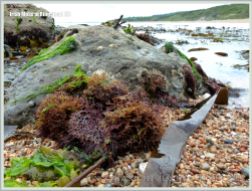Irish Moss is the common name for the red seaweed Chondrus crispus Stackhouse. It is an extremely variable, commercially exploited, seaweed and it can differ in shape, size, and colour depending on the physical environment in which it is living. Recent findings seem to indicate that another type of variation is occurring at the moment due global changing conditions. The species itself is currently the subject of extensive projects worldwide – from personal records of observations to full-scale academically rigourous research.
The shape of Irish Moss that I most frequently see on Dorset beaches is the dichotomously branched, flat bladed form with a short stipe or stalk. This is basically a red form but can be every shade of pink in the palette with varying degrees of green or greeny-yellow colour – especially at the tips of the fronds. This form doesn’t actually look anything like moss despite the name. This is the form that washed up on the beach at Ringstead by the boulders at the foot of the White Nothe cliff, and is shown in photographs 1 – 3.
However, on the same trip, I saw a seaweed that really did look like moss. It was a bright golden green which caught my eye. Made up of many fine, branched, rounded cross-sectional elements reaching no more than a centimetre or so high, it was growing epiphytically on brown fucoid seaweeds (such as Bladder Wrack, and Toothed Wrack) attached to inter-tidal boulders. I am curious to know what it really is. I have searched in texts and on-line for possibilities without finding illustrations of something identical. However, from what I have learned so far, I conclude for the moment that it is indeed another known form of Irish Moss. This is shown in photographs 6 – 8.
COPYRIGHT JESSICA WINDER 2014
All Rights Reserved









One Reply to “Irish Moss at Ringstead”